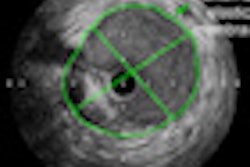
NEW YORK (Reuters Health) - Using ultrasound to gauge gestational age could put late-term female fetuses at risk of poor outcomes and even death, a new study from Sweden shows.
Indeed, up to a third of stillbirths among girls born post-term could be due to inaccuracies in these estimates, the researchers conclude.
Since the early 1990s, doctors have used second-trimester ultrasound measurements to determine the age of a fetus and estimate when the baby will be born, Dr. Alkistis Skalkidou of Uppsala Universitet and colleagues note in their paper, published online August 27 in Epidemiology.
But female fetuses, even at the end of the first trimester of pregnancy, are smaller than male fetuses, on average, Dr. Skalkidou and colleagues add, raising the possibility that a smaller, post-term female fetus could be misclassified as having a younger gestational age based on ultrasound measurements.
To investigate, the researchers looked at data from the Swedish Medical Birth Register for 1973-1978, when doctors based fetal age estimates on the date of a woman's last menstrual period, and for 1995-2007, when they used ultrasound measurements. They analyzed gender differences in outcomes for babies born at 39 to 43 weeks' gestation during both time periods.
For the first time period, which included nearly 430,000 births, there were no gender differences in gestational age at delivery, and adverse outcomes were actually more common among boys.
For the nearly 770,000 births during the second time period, the ratio of boys to girls steadily increased with gestational age, seemingly suggesting that ultrasound dating reduced the risk of post-term birth for females. However, the researchers found that adverse outcomes were substantially more common for girls than boys during the second time period, indicating that post-term pregnancies with girls were simply not being recognized as such because the girls were smaller.
This "systemic misclassification" of female babies by size, the researchers write, was putting girls at higher risk of becoming more severely post-term than anyone realized, and exposing them to all the hazards that go along with that situation.
During the period when ultrasound dating was used, the risk of stillbirth for girls was 60% higher than for boys, and the risk of meconium aspiration was 40% higher for the girls.
Based on the findings, the researchers say, healthcare providers should use gestational age estimates based on a woman's last menstrual period, as well as ultrasound measurements, to date late-term and post-term pregnancies.
Source: http://link.reuters.com/cem25p
Epidemiology 2010.
Last Updated: 2010-09-23 18:55:05 -0400 (Reuters Health)
Related Reading
MR amniotic fluid spectroscopy assesses late gestational age, May 28, 2010
Delivery date change after ultrasound linked with fetal growth restriction, April 14, 2008
Copyright © 2010 Reuters Limited. All rights reserved. Republication or redistribution of Reuters content, including by framing or similar means, is expressly prohibited without the prior written consent of Reuters. Reuters shall not be liable for any errors or delays in the content, or for any actions taken in reliance thereon. Reuters and the Reuters sphere logo are registered trademarks and trademarks of the Reuters group of companies around the world.


















